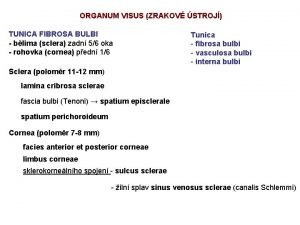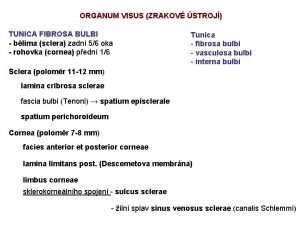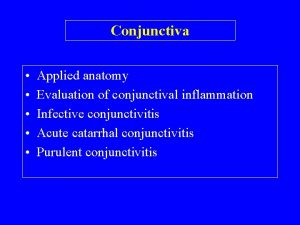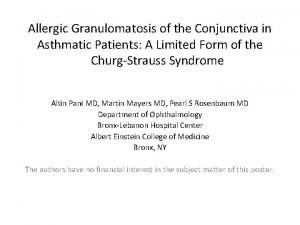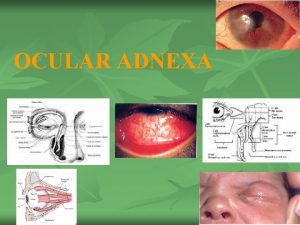Conjunctiva Anatomy of the conjunctiva conjunctiva is a





































- Slides: 37

Conjunctiva

Anatomy of the conjunctiva • conjunctiva is a thin, transparent mucous membrane which lines the inside of the eyelids and covers the sclera, it’s composed of rare stratified columnar epithelium.

The conjunctiva is typically divided into three parts: 1 - Palpebral or tarsal conjunctiva : lines the eyelids. 2 - Bulbar conjunctiva : covers the eyeball, over the sclera. 3 - Fornix conjunctiva : Forms the junction between the bulbar and palpebral conjunctivas.


Layers of the conjunctiva 1) The epithelium : is non-keratinizing and around five cell layers deep. 2) The stroma (substantia propria) : consists of richly vascularized loose connective tissue. 3) Conjunctiva-associated lymphoid tissue (CALT): is critical in the initiation and regulation of ocular surface immune responses.

Function of the conjunctiva • The conjunctiva : 1) helps lubricate the eye by producing mucous and tears. 2) contributes to immune surveillance. 3) helps to prevent the entrance of microbes into the eye.

Inflammatory diseases of the conjunctiva

BACTERIAL CONJUNCTIVITIS Bacterial conjunctivitis is commonly caused by staphylococci, streptococci, chlamydial organism, and gonocci. Mild conjunctivitis is usually benign and self-limited and can be easily treated with antibiotics. Severe conjunctivitis, such as that caused by gonococci, can cause blindness and can signify a severe underlying systemic disease. • Signs & Symptoms : * Redness of the eyes. * Discharge (purulent white yellow). * Ocular irritation. Treatment : * This condition is usually self-limiting 10 -14 days, although a broad spectrum antibiotic eye drops 1 -3 days will resolve the condition. Dx : * Conjunctival swabs for culture are indicated if the condition fails to resolve.

BACTERIAL CONJUNCTIVITIS

OPHTHALMIA NEONATORUM ** which refers to any conjunctivitis that occurs in the first 28 days of neonatal life. It commonly occurs in neonates due to maternal vaginal infection. ** neonatal conjunctivitis, with Chlamydia being the most common infectious agent. Infants may acquire these infective agents as they pass through the birth canal during the birth process.

OPHTHALMIA NEONATORUM Severe purulent discharge and eyelid edema in a newborn with gonococcal conjunctivitis (confirmed with Gram stain and culture).

VIRAL CONJUNCTIVITIS ** Viruses are a common cause of conjunctivitis in patients of all ages. ** Adenovirus is by far is the most common cause, and herpes simplex virus (HSV) is the most problematic ** Patients with viral conjunctivitis may give a history of recent exposure to an individual with red eye at home, school, or work because it’s highly contagious, or they may have a history of recent symptoms of an upper respiratory tract infection. ** Viral infection is characterized commonly by an acute follicular conjunctival reaction and preauricular adenopathy and it may be unilateral or bilateral. ** Viral conjunctivitis, although it’s usually benign and self-limited, tends to follow a longer course lasting for approximately 2 -4 weeks.

** Signs & Symptopms : - Ocular itching & foreign body sensation. - Tearing - Redness - Discharge - Lid oedema. - Photophobia. ** This is distinguished from bacterial conjunctivitis by: * A watery and limited purulent discharge. * Presense of follicles*. * Enlarged preauricular lymph nodes.

VIRAL CONJUNCTIVITIS

Follicular reaction on lower eyelids of viral conjunctivitis

ü Follicles : These are raised, gelatinous, oval lesions about 1 mm in diameter found usually in the lower tarsal conjunctiva and upper tarsal border, and occasionally at the limbus. Each follicle represents a lymphoid collection with its own germinal center. Unlike papillae, the causes of follicles are more specific (e. g. viral and chlamydial infections).

CHLAMYDIAL INFECTIONS ** Chlamydia trachomatis are responsible for two forms of ocular infections: 1 - Inclusion keratoconjunctivitis 2 - Trachoma

1 - Inclusion keratoconjunctivitis : ** It’s a sexually transmitted disease, the patient present with mucopurulent follicular conjunctivitis and develop Micropannus* with subepithelium scarring. ** Diagnosis is confirmed by detection of chlamydial antigens, using immunofluorescence or by identification of typical inclusion bodies by Giemsa staining conjunctival swab or scrape specimens. ** Treated by topical and systemic tetracycline

2 - Trachoma ** The commonest infective cause of blindness in the word although it’s uncommon in developed countries. ** The disease is encouraged by poor hygiene and overcrowding in a dry, hot climate. ** The housefly acts as a vector. ** The hallmark of the disease is subconjunctival fibrosis caused by frequent re-infection associated with the unhygienic condiotions. ** Blindness may occur due to corneal scarring from recurrent keratitis and trichiasis. ** Trachoma is treated with oral or topical tetracycline or erythromycin. ** Entropion and trichiasis require surgical correction.

the upper lidkjifgb • scarring of upper eyelid scaring of the cornea

Trachoma

ALLERGIC CONJUNCTIVITIS *It’s divided into acute and chronic forms: 1 -Acute (hay fever conjunctivitis)*: acute Ig. E-mediated reaction to airborne allergen usually pollens. * Signs & Symptoms include : >> Itching. >> Conjunctival injection and swelling (chemosis). >> Lacrimation.

Acute allergic conjunctivitis

2 - Vernal conjunctivitis (spring catarrh) : ﺍﻟﺮﻣﺪ ﺍﻟﺮﺑﻴﻌﻲ Is mediated by Ig. E, it affects male children with hx of Atopy. * Signs & Symptoms include : >> Itching. >> Photophobia. >> Lacrimation. >> papillary conjunctivitis on the upper tarsal plate, papilla may coalesce to form Giant (cobblestone). >> limbal follicles and white spots. >> punctate lesions on the corneal epithelium. >> an opaque, oval plaque which in severe disease replaces an upper zone of the corneal epithelium.

** Initial therapy is with antihistamines and mast cell stabilizeres , topical steroids are required in severe cases but long-term use is avoided if possible because of the possibility of steroid induced glaucoma or cataract. ** Contact lens wearer may develop an allergic reaction to the lens or to lens cleaning material leading to giant papillary conjunctivits (GPC)* with mucoid discharge on the upper tarsal plate , while this may respond to topical treatment with mast cell stabilizers it is often necessary to stop lens wear for a period or even permanently. Some patients are unable to continue contact lens wear due to recurrence of the symptoms.

Signs ü Papillae: These are raised lesions on the upper tarsal conjunctiva, about 1 mm in diameter with a central vascular core. They are non-specific signs of chronic inflammation. They result from fibrous septa between the conjunctiva and sub conjunctiva which allow only the intervening Papillae tissue to swell with inflammatory infiltrate. Giant papillae, found in allergic eye disease, are formed by the coalescence of papillae.

Palpebral Vernal conjunctivitis Limbal Vernal conjunctivitis

Complication of vernal conjunctivitis is Keratoconus

Conjunctival Degeneration ** Pinguecula : it’s a common benign asymmptomatic degeneration of the collagen fibers of conjunctival stroma. * You notice a small yellow white nodule usually near the limbus nasally. *It happens due to excessive exposure to UV light *No treatment requires, only if inflamed use mild topical steroids. ** Pterygium : a triangular wing shaped continous growth of the degenerative conjunctival tissue over the limbus toward the cornea. * Treatement by surgery if threatens visual axis.

Pterygium Pinguecula

CONJUNCTIVAL TUMOURS >> It’s Rare! 1 - Sequamous cell CA : irregular raised area of conjuctiva may invade deeper tissue. 2 - Malignant melanoma : The differential diagnosis from benign pigmented lesions (for example a naevus) may be difficult. Review is necessary to assess whether the lesion is increasing in size. >> Biopsy, to achieve a definitive diagnosis, may be required.

Sequamous cell CA Malignant melanoma

Band Keratopathy Subepithelial deposition of calcium phosphate in • the exposed part of the cornea.

Seen in chronic uveitis / glaucoma May cause visual loss or discomfort if. epithelial erosion form over the band If symptomatic : scraped off surgically, aided by chelating agent (sodium adetate) (& excimer laser (ablating affected surface Can also be sign of systemic hypercalcemia • •

Foreign Body Most common cause : “spark metal” • Treatment: • 1 - Must be removed + evert eyelids 2 - Antibiotics 3 - Treat as corneal abrasion 4 - CT scan if hx suggests a foreign body in posterior segment of the eye.


Thank you Lena Alshraa
 Conjunctiva anatomy
Conjunctiva anatomy Organum visus
Organum visus Icd 10 corpus alienum telinga
Icd 10 corpus alienum telinga Teoremele sunt propoziții adevărate care
Teoremele sunt propoziții adevărate care Processus ciliares
Processus ciliares Thiếu nhi thế giới liên hoan
Thiếu nhi thế giới liên hoan Alleluia hat len nguoi oi
Alleluia hat len nguoi oi điện thế nghỉ
điện thế nghỉ Một số thể thơ truyền thống
Một số thể thơ truyền thống Trời xanh đây là của chúng ta thể thơ
Trời xanh đây là của chúng ta thể thơ Hệ hô hấp
Hệ hô hấp Các số nguyên tố
Các số nguyên tố Tia chieu sa te
Tia chieu sa te đặc điểm cơ thể của người tối cổ
đặc điểm cơ thể của người tối cổ Tỉ lệ cơ thể trẻ em
Tỉ lệ cơ thể trẻ em Các châu lục và đại dương trên thế giới
Các châu lục và đại dương trên thế giới ưu thế lai là gì
ưu thế lai là gì Các môn thể thao bắt đầu bằng từ đua
Các môn thể thao bắt đầu bằng từ đua Tư thế ngồi viết
Tư thế ngồi viết Cái miệng nó xinh thế chỉ nói điều hay thôi
Cái miệng nó xinh thế chỉ nói điều hay thôi Hình ảnh bộ gõ cơ thể búng tay
Hình ảnh bộ gõ cơ thể búng tay Mật thư tọa độ 5x5
Mật thư tọa độ 5x5 Tư thế ngồi viết
Tư thế ngồi viết Voi kéo gỗ như thế nào
Voi kéo gỗ như thế nào Thẻ vin
Thẻ vin V. c c
V. c c Thể thơ truyền thống
Thể thơ truyền thống Từ ngữ thể hiện lòng nhân hậu
Từ ngữ thể hiện lòng nhân hậu Hươu thường đẻ mỗi lứa mấy con
Hươu thường đẻ mỗi lứa mấy con Thế nào là hệ số cao nhất
Thế nào là hệ số cao nhất Diễn thế sinh thái là
Diễn thế sinh thái là Vẽ hình chiếu vuông góc của vật thể sau
Vẽ hình chiếu vuông góc của vật thể sau Lp html
Lp html Làm thế nào để 102-1=99
Làm thế nào để 102-1=99 Lời thề hippocrates
Lời thề hippocrates Tư thế worm breton là gì
Tư thế worm breton là gì đại từ thay thế
đại từ thay thế Vẽ hình chiếu đứng bằng cạnh của vật thể
Vẽ hình chiếu đứng bằng cạnh của vật thể

